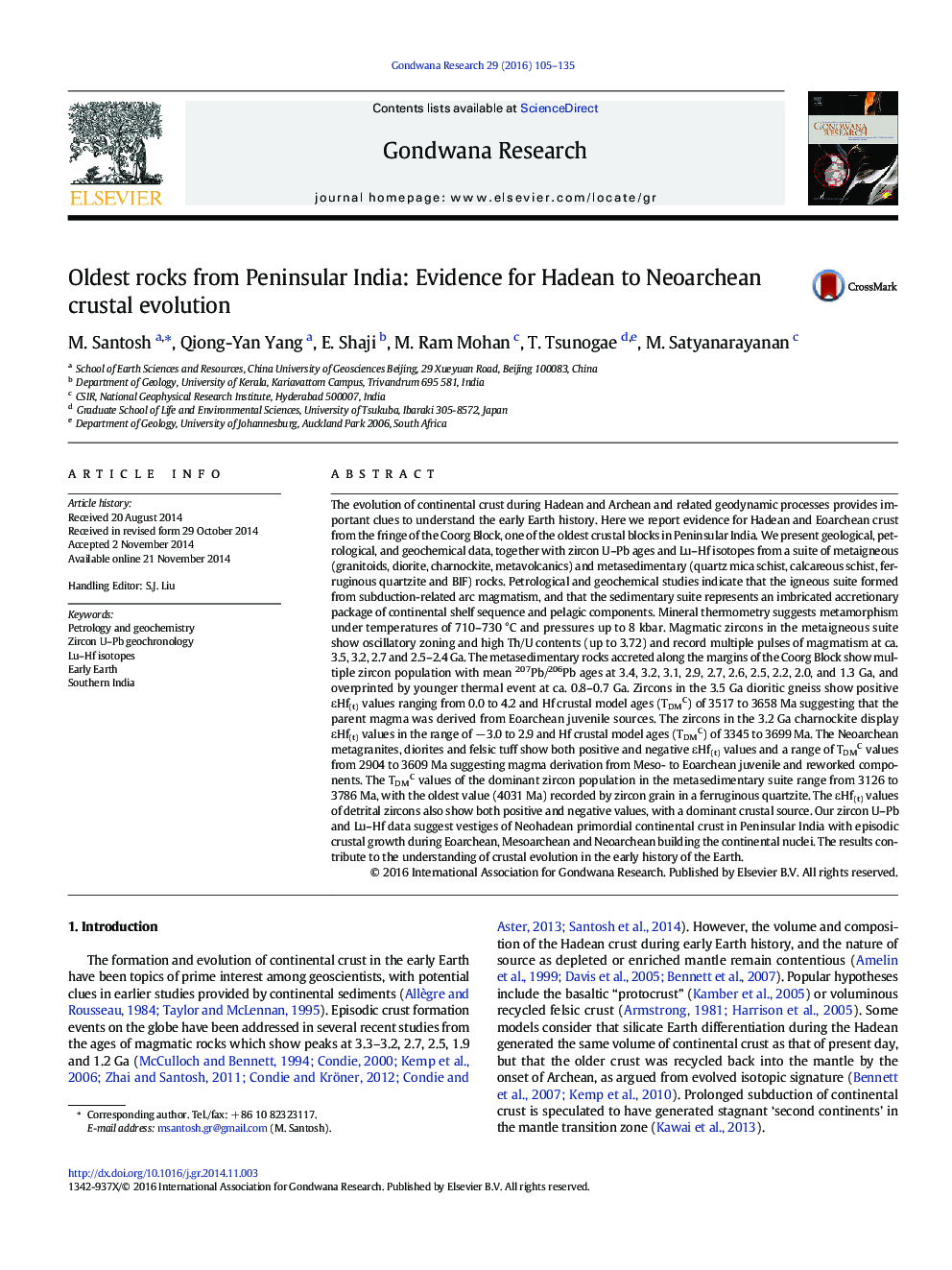| کد مقاله | کد نشریه | سال انتشار | مقاله انگلیسی | نسخه تمام متن |
|---|---|---|---|---|
| 4726774 | 1356346 | 2016 | 31 صفحه PDF | دانلود رایگان |

• Episodic magmatism during Eoarchean, Mesoarchean and Neoarchean
• Magmatic pulses related to subduction tectonics in convergent margins
• Evidence for Hadean felsic continental crust
• Heterogeneous source reservoirs involving juvenile and reworked components
The evolution of continental crust during Hadean and Archean and related geodynamic processes provides important clues to understand the early Earth history. Here we report evidence for Hadean and Eoarchean crust from the fringe of the Coorg Block, one of the oldest crustal blocks in Peninsular India. We present geological, petrological, and geochemical data, together with zircon U–Pb ages and Lu–Hf isotopes from a suite of metaigneous (granitoids, diorite, charnockite, metavolcanics) and metasedimentary (quartz mica schist, calcareous schist, ferruginous quartzite and BIF) rocks. Petrological and geochemical studies indicate that the igneous suite formed from subduction-related arc magmatism, and that the sedimentary suite represents an imbricated accretionary package of continental shelf sequence and pelagic components. Mineral thermometry suggests metamorphism under temperatures of 710–730 °C and pressures up to 8 kbar. Magmatic zircons in the metaigneous suite show oscillatory zoning and high Th/U contents (up to 3.72) and record multiple pulses of magmatism at ca. 3.5, 3.2, 2.7 and 2.5–2.4 Ga. The metasedimentary rocks accreted along the margins of the Coorg Block show multiple zircon population with mean 207Pb/206Pb ages at 3.4, 3.2, 3.1, 2.9, 2.7, 2.6, 2.5, 2.2, 2.0, and 1.3 Ga, and overprinted by younger thermal event at ca. 0.8–0.7 Ga. Zircons in the 3.5 Ga dioritic gneiss show positive εHf(t) values ranging from 0.0 to 4.2 and Hf crustal model ages (TDMC) of 3517 to 3658 Ma suggesting that the parent magma was derived from Eoarchean juvenile sources. The zircons in the 3.2 Ga charnockite display εHf(t) values in the range of − 3.0 to 2.9 and Hf crustal model ages (TDMC) of 3345 to 3699 Ma. The Neoarchean metagranites, diorites and felsic tuff show both positive and negative εHf(t) values and a range of TDMC values from 2904 to 3609 Ma suggesting magma derivation from Meso- to Eoarchean juvenile and reworked components. The TDMC values of the dominant zircon population in the metasedimentary suite range from 3126 to 3786 Ma, with the oldest value (4031 Ma) recorded by zircon grain in a ferruginous quartzite. The εHf(t) values of detrital zircons also show both positive and negative values, with a dominant crustal source. Our zircon U–Pb and Lu–Hf data suggest vestiges of Neohadean primordial continental crust in Peninsular India with episodic crustal growth during Eoarchean, Mesoarchean and Neoarchean building the continental nuclei. The results contribute to the understanding of crustal evolution in the early history of the Earth.
Figure optionsDownload as PowerPoint slide
Journal: Gondwana Research - Volume 29, Issue 1, January 2016, Pages 105–135